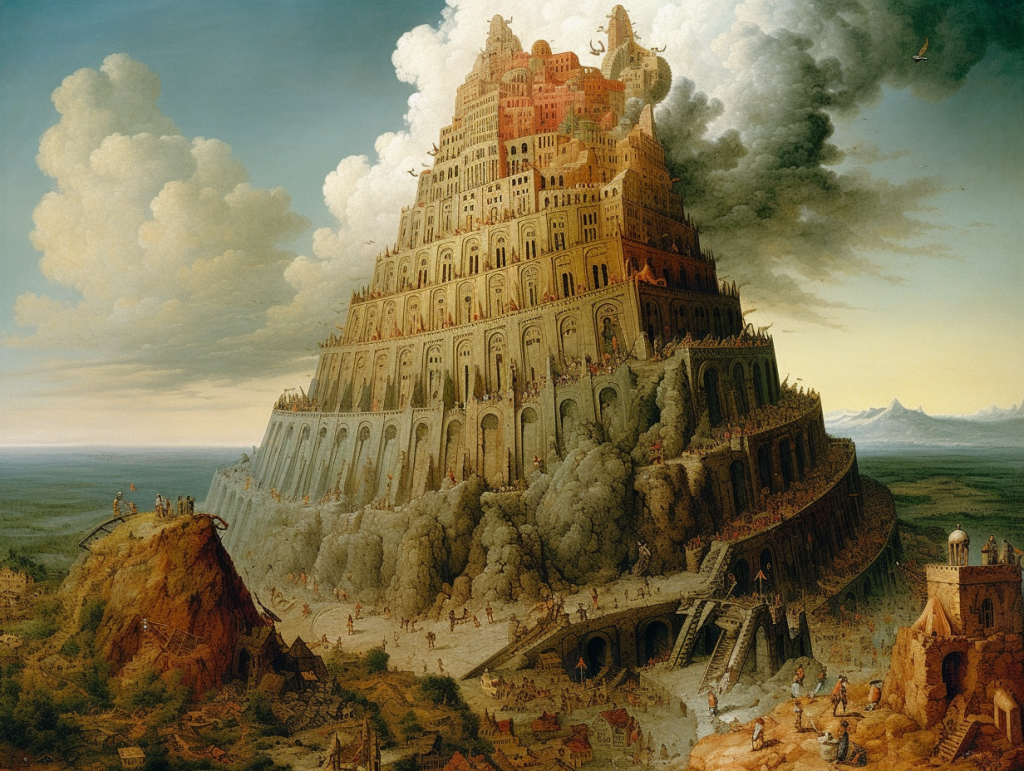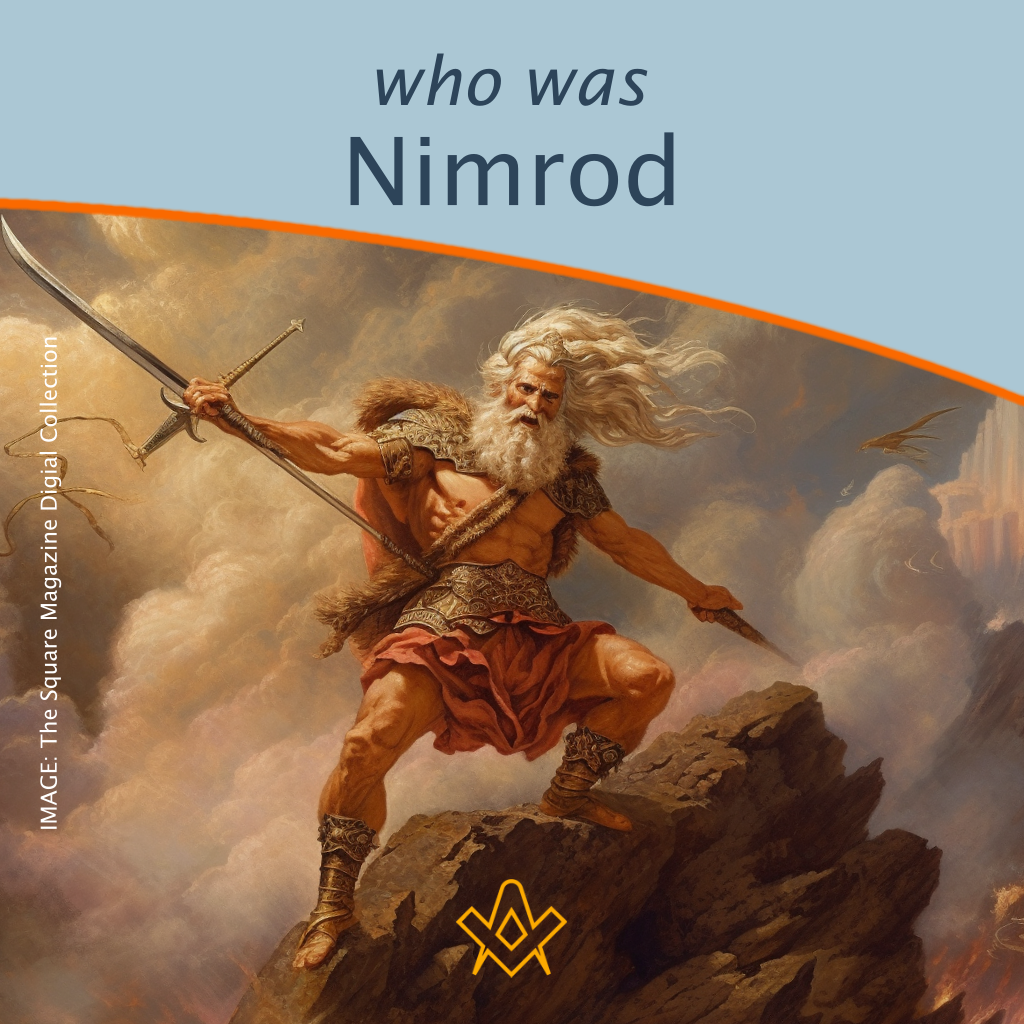The connection between Freemasonry and the biblical figure Nimrod has been a subject of debate and speculation for many years.
While mainstream Masonic scholarship does not recognise any direct association between the two, varying interpretations and conspiracy theories emerge that link them together.
Freemasonry is a fraternal organization that can be traced back to the medieval stonemason guilds.
Over time, the organization has evolved and incorporated various symbolic and philosophical elements from different sources, including religious and mythological figures.
Freemasonry emphasizes moral and ethical teachings, personal development, and brotherhood. Although it includes references to various religious figures, the organization itself is not affiliated with any particular religion.
The Biblical Figure Nimrod
Nimrod is a character mentioned in the Book of Genesis, where he is described as a great-grandson of Noah and a mighty hunter. Some interpretations of the Bible associate Nimrod with the construction of the Tower of Babel, portraying him as a powerful and ambitious ruler.
Negative portrayals of Nimrod often depict him as a tyrant, while alternative interpretations have attempted to present him in a more positive light, focusing on his leadership and contributions to human civilization.
One significant aspect of the negative portrayals of Nimrod is his role as a tyrannical ruler. Critics suggest that under his leadership, people were oppressed, and he went to great lengths to consolidate his power.
According to this point of view, Nimrod’s reign was marked by cruelty, tyranny, and despotism. This interpretation is primarily based on legends and external texts rather than direct evidence from the Bible.
Nimrod’s Involvement in the Tower of Babel

Tower of Babel
IMAGE CREDIT: the square magazine digital collection
The story of the Tower of Babel is found in the Book of Genesis, where humanity comes together to build a city and a tower that reaches the heavens.
The motive behind this ambitious project is often attributed to a desire for attaining greater power and establishing a name for themselves, as stated in Genesis 11:4:
“Come, let us build ourselves a city, and a tower with its top in the heavens, and let us make a name for ourselves; otherwise we shall be scattered abroad upon the face of the whole earth.”
Although Nimrod is not explicitly mentioned in the specific portion of the narrative in the Bible, scholars and interpreters have made a connection between him and the Tower of Babel due to his reputation as a mighty hunter and a ruler of multiple cities.
Some ancient Jewish sources, such as the Talmud and the Midrash, further associate Nimrod with the Tower of Babel episode. According to these sources, he was either the initiator or the primary supporter of the tower’s construction.
The association of Nimrod with the Tower of Babel can be viewed in two distinct ways. Critics often interpret his involvement as evidence of his hubris and rebellion against divine authority, attempting to usurp God’s rule and challenge his power.
Conversely, more positive interpretations regard his involvement as representative of his ambition and drive to advance human civilization, albeit with possible misconceptions of its consequences.
The Connection with Freemasonry
The connection between Freemasonry and Nimrod’s involvement in the Tower of Babel is primarily derived from speculative interpretations and conspiracy theories. Some people believe that the Masons trace their spiritual origins back to the builders of the Tower of Babel, and that Nimrod, as the initiator or primary supporter of the project, played a crucial role in the establishment of Freemasonry.
In this view, the tower represents the first large-scale joint effort in engineering and architecture, laying the foundation for the traditions and practices of masonry.
Some conspiracy theories claim that Nimrod was a founder or significant figure in the secret society of Freemasonry. These theories allege that Freemasonry perpetuates or carries on Nimrod’s legacy and seeks to establish a new world order.
However, it is essential to recognize that such claims lack credible historical or factual evidence. Most Masonic scholars and experts dismiss such theories as unfounded and baseless.
Alternative perspectives on Nimrod’s character portray him as a skilled leader and protector, emphasizing his ability to unite people and establish societal structures.
These interpretations suggest that Nimrod played a critical role in maintaining order and security within his domains, effectively organizing and governing communities.
According to some viewpoints, Nimrod can be considered a central figure in the development of human civilization. This perspective associates him with the founding of cities and the advancement of cultural and technological achievements.
By emphasising his contributions to urbanization and the establishment of social institutions, these interpretations cast Nimrod as a catalyst for progress and civilization.
It is worth noting that positive interpretations of Nimrod are not universally accepted or supported, as the biblical text itself provides limited information about the character. Nevertheless, these alternative perspectives provide a different lens through which to view the story of Nimrod.
Freemasonry and Nimrod: Assessing the Connections
When examining the connections between Freemasonry and Nimrod, it is crucial to differentiate between solid evidence and unfounded speculation.
No credible historical or factual evidence supports a direct connection between Freemasonry as an organization and Nimrod. Most Masonic scholars dismiss such claims as baseless.
Freemasonry incorporates a wide range of symbols, allegory, and references from various sources, including biblical and mythological figures.
However, their emphasis is on moral and ethical teachings, personal development, and brotherhood, rather than specific religious or historical figures. As such, any attempt to draw a direct link between Freemasonry and Nimrod is unsubstantiated.
Moreover, it is essential to recognize that interpretations of Nimrod’s character and actions are diverse and not universally agreed upon. While some portray him as a tyrant or as involved in the Tower of Babel narrative, others present him as a skilled leader and essential figure in human civilization development.
Each perspective should be assessed critically, taking into account the limitations of the biblical text and the potential influence of external factors, such as cultural or religious biases.
Overall, the connection between Freemasonry and Nimrod is one of speculation and interpretation, rather than evidence-based fact. While some conspiracy theories and fringe connections suggest a direct link between the two, mainstream Masonic scholarship does not endorse or recognize such a relationship.
By examining the different perspectives on Nimrod’s character and assessing the degree to which these interpretations are supported by the biblical text, it becomes clear that any direct association between Freemasonry and Nimrod is unfounded.
Freemasonry’s emphasis on moral and ethical teachings, personal development, and brotherhood further distances the organization from specific historical or religious figures, including Nimrod.
Article by: Maarten Moss

Maarten Moss writes regularly as a guest author
Recent Articles: masonic history
 Protestantism and Masonic Influence in Brazil Discover the untold story of how Freemasons helped Southern Americans immigrate to Brazil post-Civil War, fostering economic and educational growth in Santa Bárbara d’Oeste and Americana. Learn about their pivotal role in establishing Protestant churches and ensuring the secularity of the Brazilian State amidst a Catholic-dominated society. |
 Explore the proper use of the sacred word in Brazilian Freemasonry through an analysis of Masonic literature and Bible translations. Uncover the errors in pronunciation and the need for corrections to maintain liturgical coherence in rituals. Discover insights on Masonry, rituals, and the Hebrew word Boaz. |
 Narratives of History |
 A Very Royal Sesquicentenary |
 Unveiling the Enigma: Discover the Royal Society's Legacy and its Impact on Science. Delve into the fascinating history of the Royal Society, the prestigious UK academy shaping scientific progress since 1660. Explore its pivotal role in advancing knowledge, fostering collaboration, and unlocking the secrets of the universe. Prepare to be amazed! |
 Knights Templar in Freemasonry Uncover the Mysteries of the Knights Templar in Freemasonry! Delve into the intriguing world where chivalry and symbolism intertwine. Discover the captivating rituals and ancient secrets behind the Knights Templar Masonic Orders. Explore the historical connection and delve into the enigmatic narratives that continue to fascinate enthusiasts today. Unveil the hidden truths now! |
 The Royal Arch stands as the rainbow of promise in the Ritual; it stands as the promise of the resurrection; of that which was lost and that it shall be recovered. The question arises as to whether the Master's Word was originally communicated in the Third Degree? On this point there is some diversity of opinion. Originally published in 1915, this insight into the Fourth Degree – the Holy Royal Arch – is as relevant today as it was over 100 years ago. |
 Unveiling the Mysteries of Druidism: Discover the Intriguing Connection with Freemasonry. Explore the ancient spiritual practice of Druidism and its fascinating ties to the enigmatic world of Freemasonry. Delve into the shared symbolism and rituals that have captivated minds for centuries. Unlock the secrets of these intertwined traditions today! |
 Uncover the legacy of freestone masons and their pivotal role in crafting medieval cathedrals. Discover the artistry behind their techniques, the hierarchy within their craft, and the enduring impact of their intricate carvings. A deep dive into the world of these master craftsmen awaits you! |
 Unearth the intriguing journey from Vincha Culture to Freemasonry. Discover how ancient building methods intertwine with modern Masonic philosophies. This exploration will shed light on the fascinating link between the Serbian term "shestarenye" and the symbolic significance of the compass in Freemasonry. |
 Freemasonry and the Illuminati Unravel the enigmatic world of Freemasonry and the Illuminati in our latest exposé. Dive into centuries-old mysteries, debunk conspiracy theories, and discover the truth behind these elusive societies. Are they puppet masters or mere myths? Join us as we dissect history and fact from fiction. |
 The Île des Templiers, or “Island of the Templars” lies within a leafy park in Paris. The execution site of Jacques du Molay, the last Grand Master of the Knights’ Templar bears a plaque with the epitaph ‘A cet endroit / Jacques de Molay / Dernier grand maître / de l'ordre du temple / a été brûlé le 18 Mars 1314’ (‘In this location / Jacques de Molay / Last grand master / of the order of the temple / was burned on 18 March 1314’) |
 Operative Progressions to Speculative Masonry Both Operative and Speculative Masonry are an important part of the modern fraternity of Freemasonry, which combines elements of both traditions. Today, Freemasonry is a fraternity that is open to men of good character, who are interested in personal development and in making a positive contribution to their communities. |
 General Regulations of a Free Mason, 1723 General Regulations of a Free Mason as contained in Anderson's Constitutions of the Freemasons, published 1723. the Regulations are of great historical interest. Compiled by George Payne, the second Grand Master of the Premier Grand Lodge of England, they were printed in 1722/3, thus published just over five years after the formation of the Grand Lodge 1717. |
 The Genesis of the 1723 Book of Constitutions 2023, marks the three hundredth anniversary of the publication of the first printed Book of Constitutions of the Grand Lodge formally established in London two years previously. This is an anniversary whose significance extends beyond freemasonry. A paper by Andrew Prescott |
 The Ritual of the Operative Free Masons - P3 Existing Operative Free Masons. The ritual I am about to refer, is that of "The Worshipful Society of Free Masons, Rough Masons, Wallers, Slaters, Paviors, Plaisterers, and Bricklayers." By Thomas Carr, M.D., P. M. Honorary Member of the Guild of Operative Free Masons |
 Liberté chérie was a Masonic Lodge founded in 1943 by Belgian Resistance fighters and other political prisoners at Esterwegen concentration camp. It was one of the few lodges of Freemasons founded within a Nazi concentration camp during the Second World War. |
 The Ritual of the Operative Free Masons - P2 If anyone doubts the fact that the formation of Speculative Free Masonry was due to and based upon Operative Free Masonry, it is quite easy to convince him of his error if he will only study the first Book of Constitutions. By Thomas Carr, M.D., P. M. Honorary Member of the Guild of Operative Free Masons |
 In 1881, Freemasonry rose from the ashes of a fire in the mining town of Kokomo, Summit County, Colorado. Corinthian Lodge No. 42, along with Kokomo, no longer exists but it holds the record of having been – at an elevation of 10,618 feet – the highest Masonic Lodge in the USA. |
 The Huguenots and Early Modern Freemasonry The Huguenots influence in the development of early modern Freemasonry at the time of the formation of the Grand Lodge in London around 1717 / 1723. |
 November is a month of reflection – perhaps due to the fact that we are getting close to the years' end – but also because Remembrance / Armistice Day (11 November) is a significant date in most countries' diaries. |
 Speculative Freemasonry, as practise by Grand Lodge of England, was officially born just over three hundred years ago, is today an international organisation, counting over six million members. It has been subjected to persecution, suppression, and abolition throughout its history. In its infancy, only a couple of decades after its official birth, it had already become a target. |
 The Ritual of the Operative Free Masons - P1 The original paper was written, first, to prove that Speculative Free Masonry was derived from Operative Free Masonry; second, to give some account of the Operative Free Masons, of their Ritual, and of their customs. By Thomas Carr, M.D., P. M. Honorary Member of the Guild of Operative Free Masons |
 American Fraternalism in the 19th and Early 20th Centuries The late 19th and early 20th centuries in the United States has been called the "Golden Age of Fraternalism." How did this come about and why was the idea of joining a fraternal organization so popular? We will explore this question and examine the regalia used by many fraternal organizations in this period. |
 Societas Draconistarum, meaning "Society of the Dragonists"– was a chivalric Order for selected nobility, founded in 1408 by Sigismund von Luxembourg, who through marriage became the King of Hungary (1387–1437) and later Holy Roman Emperor. The Order was fashioned after the military orders of the Crusades, requiring its initiates to defend the cross and fight the enemies of Christianity, in particular the Ottoman Empire. |
 The Perjured Free Mason Detected Was Samuel Prichard a perjured individual, or simply a misguided Freemason? Prichard's book "Free Masonry Dissected" published in 1730, is now used by many Masonic historians as a source of reference with regards to the introduction of the third degree into the Craft. But at the time it was published in 1730, it was not so well received by members of the Grand Lodge of England. |
 17th century and the Holy Royal Arch This article focuses on a period of transition between a point in time when we can safely and historically identify the first formation of what could be called as the ‘Royal Arch’ and the historical events that have preceded it. |
 Most Freemasons have heard the terms 'Operative' and 'Speculative' Masons, and this article helps to understand the difference: |
 Roberts' Constitutions of Freemasonry 1722 Published a year before Anderson's Constitutions, The Old Constitutions Belonging to the Ancient and Honourable SOCIETY OF Free and Accepted MASONS. Originally printed in London England; Sold by J. Roberts, in Warwick-Lane, MDCCXXII.(1722) |
 From 'Songs of religion and life', 1876 by John Stuart Blackie (1809-1895) |
 On the Antiquity of Masonic Symbolism Is the Symbolism of Masonry an inheritance derived from the old Masons who flourished before the era of the Grand Lodges (1717); or has it been borrowed from the Rosicrucians or others, after 1717? |
 Mason's Marks – from Egypt to Europe? Mason's marks have been a source of intrigue, not only to Freemasons but to historians and archaeologists. The use of simple pictograms have been employed for millennia by artisans to identify their work. But where did they originate and why? |
 The White House Foundation Stones Further to the articles in our series on the history of the stone masons, we have a rather intriguing addition. During the 1950's renovation of the White House, President Truman retrieved more than 100 stone blocks with stonemasons marks. |
 What the Goose and Gridiron Tavern is in the ancient annals of London Freemasonry, The Green Dragon Tavern is to the memories of the Free-mason, of Boston and New England. |
 Auschwitz concentration camp: video photo article taken in 2013 |
 There are two things of importance happening this day - 27 January |
 Two approaches regarding the understanding of Freemasonry |
 Masonic Research in England c1930 An article which appeared in an American Masonic magazine, c1930 and which was reproduced in England, provoking a little controversy. |
 Masonic bookplates the ‘Brethren’s spiritual coats of arms and marks’ |
 The Unlawful Societies Act of 1799 Rebellious Freemasons and the 21st century |
 In 1912, Sarah Dowd of Dromore, Ireland, found a Masonic jewel dated 1517 - a date two hundred years before the establishment of Grand Lodge... |
 Freemasonry and Fascist Regime Interesting speech by the famous historian Prof. Aldo A. Mola, who links the fascist regime with the Masonic Associations. |
 Was famous Russian poet Alexander Pushkin a Freemason? And if so, was he a member of the lodge ‘for which all the lodges in Russia were destroyed’? |
 The Importance of Masonic Research Why is accurate - or authentic - Masonic research so important? The importance of making a daily advancement in Masonic knowledge is something that The Square is passionate about promoting. |
 The Antient Noble Order of the Gormogons had a brief existence in the eighteenth century; they left few records or accomplishments, |
masonic knowledge
to be a better citizen of the world
share the square with two brothers

click image to open email app on mobile device





